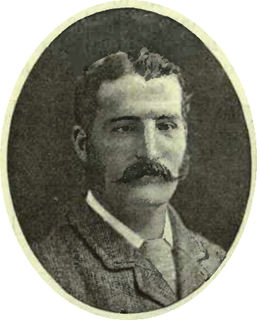Guy's, Kings and St. Thomas' Rugby Football Club ("GKT") is the name given to the modern amalgam of three formerly distinct hospital rugby clubs each with a long history, having all been founded in the nineteenth century. The teams from Guy's Hospital and St Thomas' Hospital were the first to merge following the union of their respective Medical Departments. When King's College Hospital also merged in 1999 the King's College Hospital Rugby Football Club opted to remain separate and in so doing became an open rugby club that no longer represented the Hospital Medics. GKT is notable for having been part of the twenty-one founding members of the Rugby Football Union, and across its joint history has produced many international players.
Reginald Halsey Birkett was an English footballer who played for Clapham Rovers, as well as the English national side. He also played international rugby union for England in 1871, in the first international rugby match. In this match he scored England's first try.

Edward Kewley was an English sportsman who played rugby union for England and also played first-class cricket for Lancashire. He captained England three times, and was the first captain to be drawn from the north of England as well as captaining England in the first ever 15-a-side international.
The Gipsies Football Club was a short lived 19th century rugby football club that was notable for being one of the twenty-one founding members of the Rugby Football Union, as well as producing a number of international players in the sport's early international fixtures.
Ravenscourt Park was a short lived 19th century English rugby union club that was notable for being one of the twenty-one founding members of the Rugby Football Union, as well as supplying a number of international players for the sport's early international fixtures.

Alfred St George Hamersley was a nineteenth-century solicitor and entrepreneur of great renown, an English MP, and an English rugby union international who played in the first ever international match. He went on to captain his country's team, and later was instrumental in establishing the sport in the south of New Zealand and in British Columbia.

Dr. Lennard Stokes was a rugby union international who represented England from 1875 to 1881. He also captained his country on five occasions, notably in the first ever match against Wales. Like his brother Frederick Stokes, after captaining his country he went on to become the president of the Rugby Football Union.

Francis Luscombe was a rugby union international who represented England from 1872 to 1876. He also captained his country.

Alan Rotherham was a rugby union international who represented England from 1882 to 1887. He also captained his country. Rotherham is best known for his part in revolutionising half-back play in rugby union, being the first player to demonstrate how a half-back could be the connecting link between the forwards and three-quarters, and thereby paving the way for the passing game within the backs that is practised to the present day. His role in the development of rugby was recognised by the International Rugby Board in 2011 with induction to the IRB Hall of Fame under the theme of innovation and creativity.
Henry Taylor was a rugby union international who represented England from 1879 to 1882.
William Edward Openshaw was a rugby union international who represented England from 1879 to 1879.

Dawson Turner was a rugby union international who represented England from 1871 to 1875.

Henry John Cecil Turner was a rugby union international who represented England in 1871 in the first international match.

Frank Tobin CBE was a rugby union international who represented England in the first international rugby match in 1871.

John Marshall Dugdale was a rugby union international who represented England in the first international rugby match in 1871.

John Shaw Thomson was a rugby union international who represented Scotland in the first international rugby match in 1871.

William Forsyth was a rugby union international who represented Scotland in the first international rugby match in 1871.
Charles John Cliff Touzel was an English priest who became the rector of Heswall in Cheshire. In his younger days he was a rugby union player of note, representing Cambridge University and winning two international caps for England.
John Edmund Bentley was an English sportsman who played in the first international rugby football match in 1871, representing England as a halfback.
Sydney Morse was a rugby union international who represented England from 1873 to 1875.











